f you are a corporate trainer or training specialist, you know there are numerous software that can be used for employee training. Some are great for onboarding, others fit perfectly to the skills development programs.
But how to pick the one that will suit your training goals? There, you should think of learning strategy, course development, administration, and progress tracking. Is there anything else?
Don’t forget about pricing, compatibility with other apps, and accessibility.
In this regard, we prepared a list of the best training administration software that can turn into a comprehensive solution, automate your training processes, or simply help you set up an effective training system.
Here is an overview of our top picks:
- EducateMe ― Flexible, collaborative software with robust reporting.
- Trainual ― Intuitive SOP and policy training platform.
- Docebo ― AI-powered, comprehensive LMS for skill development.
- LearnUpon ― LMS with customizable learning portals.
- Litmos ― Scalable LMS for global teams.
- TalentLMS ― Gamified LMS for scalable upskilling.
- 360Learning ― Collaborative, user-friendly LMS for knowledge sharing.
- Cornerstone ― AI-driven skill development and reporting LMS.
- Looop ― Training management system with strong automation.
- Adobe Learning Manager ― Customizable, immersive LMS for different actors.
What Is Training Management Software?
Before jumping to the best training management platforms, let’s resort to basics. What is it?
Training management software is a software or application designed to develop, administer, schedule, and track training programs for corporate actors, employees, and stakeholders.
Why training administration software is so important?
With the training management platform, corporate trainers can create a centralized approach to training provision, optimize the management of the sessions and activities, and effectively distribute information to all interested parties.
TMS vs LMS: What is the difference?
One would say, “I can use LMS for employee training, can’t I?”. And they would be right. You can use either a learning management or training management system for your training needs. However, you should know how they are different.
- A training management system (TMS) has a distinct focus on the planning and organization of training sessions, customized learning paths, and connection to the business processes.
- In comparison, the learning management system (LMS) usually underlines course delivery, reporting, and class management.
Highlight: A flexible LMS with great management, reporting, and organization can serve as a TMS.
What Is the Best Training Management Software in 2026?
Considering that the training needs of companies differ depending on the size, stage, and specific industry, we have collected different training management software in our list. Some of them are LMS with powerful automation, others are solid skill development systems.
Note. If you are seeking a tool for a specific case, then check the “Good for” section, or pick the most flexible option.
1. EducateMe: Best Training Management Software
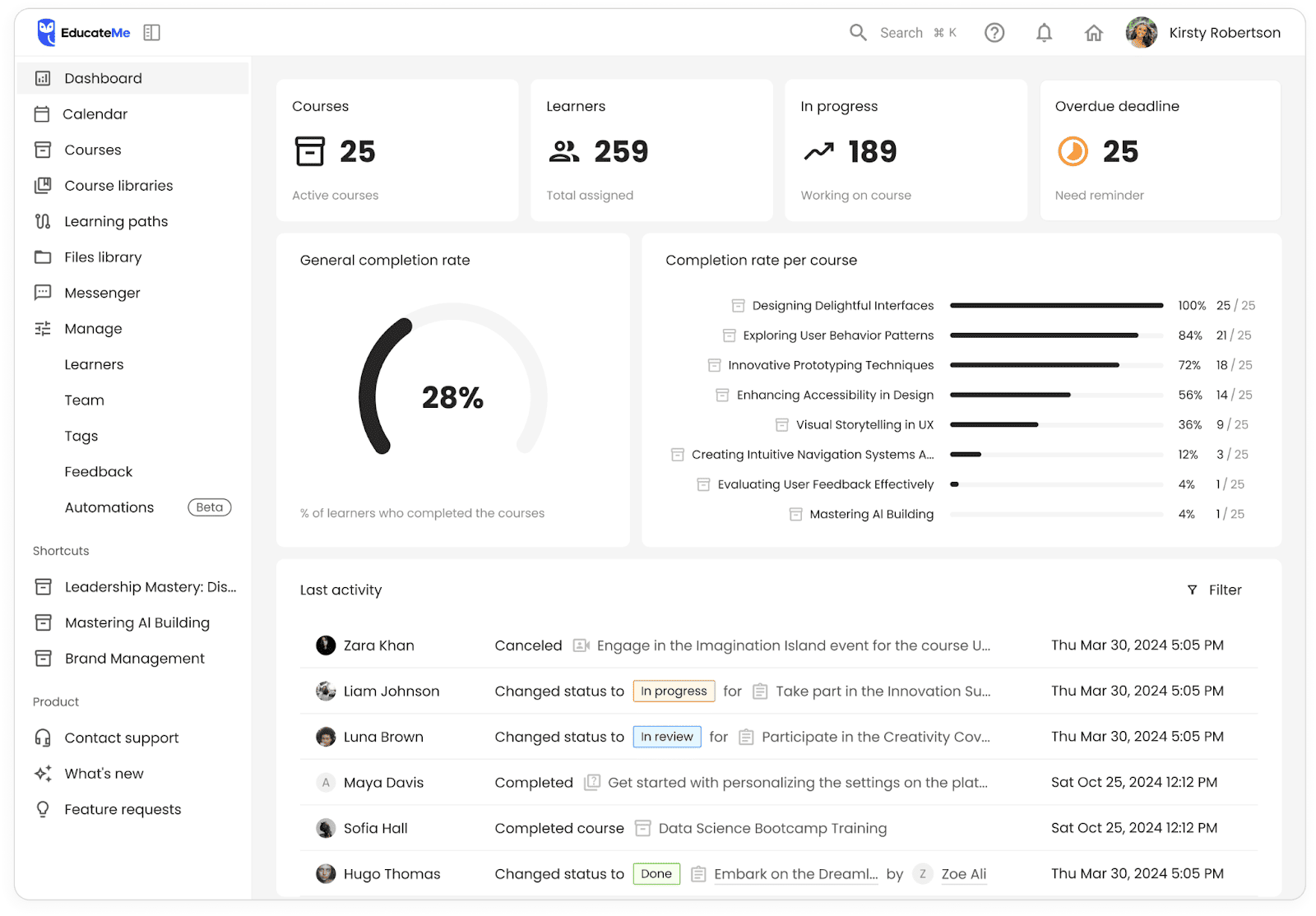
EducateMe is the best training management system that offers powerful management features, flexible course creation tools, and advanced white-label options.
With a focus on collaboration, assignment management, and reporting, it is a great LMS to hose and deliver employee training, from onboarding and skill development to specific training courses.
Its features are ideal for both synchronous and asynchronous training sessions. Notably, its powerful integration capabilities allow connecting to third-party apps for better engagement, content creation, and data transfer.
Good for: medium and large organizations with diverse employee training needs built around cooperation, collaboration, and self-paced programs.
Key features of EducateMe
- Course editor. You can add various types of course materials, activities, or lessons. It involves embedding content, adding assignments and quizzes, or using modules to break content. Besides, there is an AI tool to generate content and the ability to duplicate programs.
- Engagement tools. This training administration system offers great opportunities for cohort learning and instructor-led training sessions. You can host live sessions, offer group assignments, handle peer and instructor reviews, and use built-in messenger or comments to organize communication.
- Reporting. Another benefit of this employee training management system is robust reporting, including a dashboard, progress tracker, and feedback administration.
- Management and automation. EducateMe offers automation to handle events and send emails and uses advanced management options for employee groups, deadlines, and assignments.
- Integrations. There are powerful integrations with Loom, Zoom, Outlook, Airtable, and Slack. Besides, there is API access and the ability to implement custom solutions under Enterprise plans.
Pros of EducateMe
- Set of engagement tools that support social, cooperative, and collaborative learning programs and peer-to-peer interactions.
- Flexibility in terms of content creation and integrations.
- Thanks to the focus on cohorts, there is an advanced student management and activity automation to streamline training provision.
- White-label LMS that can be customized to suit your brand.
Cons of EducateMe
- Offers no mobile app, even though it is mobile-friendly.
- May have issues with supporting SCORM format.
2. Trainual

Another decent web based training management software is Trainual. Trainual is an intuitive and straightforward tool that allows growing businesses to manage corporate how-to’s, transform standard procedures into training programs, and define workflows.
Trainual provides a course creator tool with separate modules, a comprehensive library of course templates, and straightforward reporting. This makes it very effective for teaching corporate practices and educating on policies.
Good for: onboarding, policy training, and standard operational procedures (SOP) documenting within growing organizations.
Key features of Trainual
- Content editor: A three-step process tool that makes it very easy to create training content related to procedures, policies, and rules. You can embed content, and other Trainual pages, or use AI helper.
- Vast content library. Offers hundreds of templates for training course creation, from onboarding checklists and intros to brand messaging policies and incident guidelines.
- Training management. You can create a team directory to connect with a team in a separate hub, use an org chart to define employee roles, or bulk-share training materials by role or department.
- Decent integrations. Trainual offers integrations with Loom (to record screens and create content) or Quizkbook and Bamboo HR (to automatically add employees in TMS).
Pros of Trainual
- Easy-to-use SOP software for documenting and training provision.
- Diversity of templates to enrich onboarding.
- Functionality regarding training content creation.
- Responsive support and mobile app.
Cons of Trainual
- Lack of SCORM support.
- Customization is not advanced.
- Import tools may experience issues.
Pricing: 7-day free trial; pricing starts at $300/month with Small Plan (up to 25 employees); Medium Plan is $349/mo (up to 50 employees); Growth Plan is $499/mo (up to 100 employees); Custom Plan is available via sales.
Read more: Best Online Training Software for Organizations
3. Docebo

Docebo is a comprehensive training management solution backed by an AI engine, great reporting, and powerful automation tools.
In terms of training materials, Docebo offers content editing tools and a large content marketplace to assign courses. Besides, it offers gamification options and solid social learning tools to collaborate, communicate, and share expertise.
That way, this online training tool can be a relief for L&D departments that seek universal training management solutions to handle employee skill development and answer diverse learning needs.
Good for: skill gap closure, upskilling, and continuous learning within enterprises and large organizations.
Key features of Docebo
- AI and automation tools. Docebo offers a powerful set of AI tools that help to manage training courses. In particular, Docebo Skills can offer hyper-personalized AI experiences to close skills gaps of employees; Docebo Shape allows turning external resources into training materials on the platform automatically.
- Content marketplace. L&D specialists won’t need to resort to course providers or agencies, as Docebo offers a wide range of courses, training materials, lessons, and summaries within its content marketplace.
- Analytics. This training management platform provides a customizable dashboard with different widgets. They can be used to track various data: completion rates, skill development, NPS scores, and sales effectiveness.
Pros of Docebo
- It suits diverse and vast learning needs, offering multiple features and integrations from training content creation to mapping out skill development.
- Provides an app for mobile learning and supports the SCORM format.
- Extensive data analytics and proper tools for employee engagement.
Cons of Docebo
- Editing may be improved.
- Lack of functionality in regard to custom reports.
- Docebo is pretty expensive and won’t suit companies on a constrained budget.
Pricing: available upon request.
Read more: Best L&D Tools
4. LearnUpon
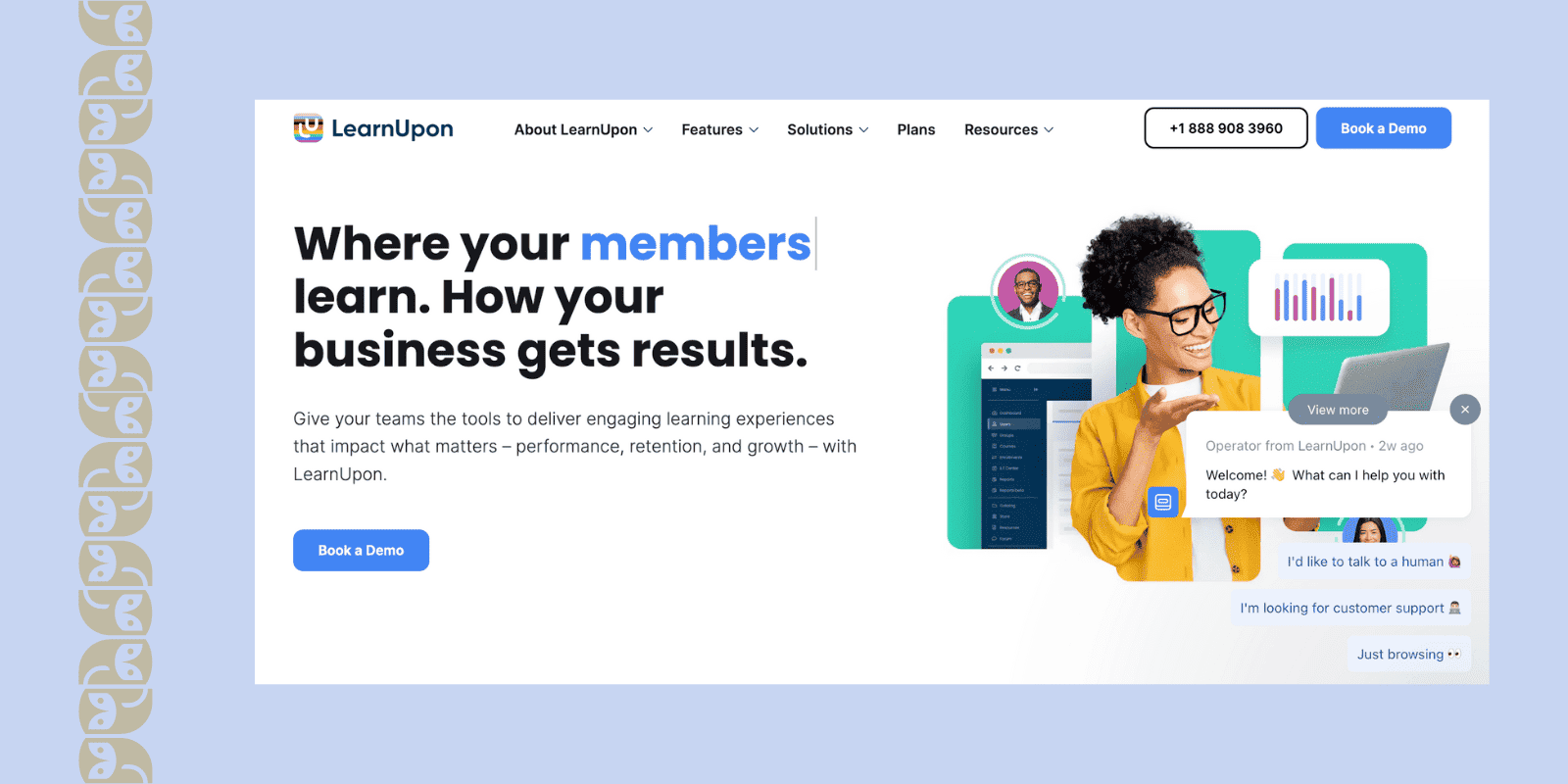
What about the tools for a more customizable training provision? LearnUpon is one of such training software. It is a responsive training management platform with which you can develop training courses via personalized learning portals.
The learning portals make it possible to develop the training spaces into sub-portals, apply branch learning, and customize learning paths for different users. It makes a good option for enterprises or companies with numerous departments and separate training needs.
Good for: corporate training, in-house training, and customized learning across different departments of large enterprises.
Key features of LearnUpon
- Customization options. With learning portals, you get advanced features to customize your training experience and space. At the same time, the LMS provides white-label options and customizable learning paths.
- Content creation: LearnUpon offers a pretty decent content variety (supporting video, xAPI, and SCORM formats), brings in instructor-led sessions, and allows linking courses or creating a resource center.
- Engagement tools. This employee training management software offers an app, comment sections, and decent gamification, like badges, level-ups, or leaderboards, for better engagement of the employees.
Pros of LearnUpon
- It is very easy-to-use and offers great navigation.
- Automation and HRIS integration capabilities are pretty good.
- Reporting options and a dashboard for progress tracking are on point.
- Offers eCommerce capabilities for training businesses.
Cons of LearnUpon
- Course authoring can be pretty basic.
- Editing of learning paths may be limited after publication.
- Email notifications may come as spam.
Pricing: after the contact with sales or request for a demo.
5. Litmos
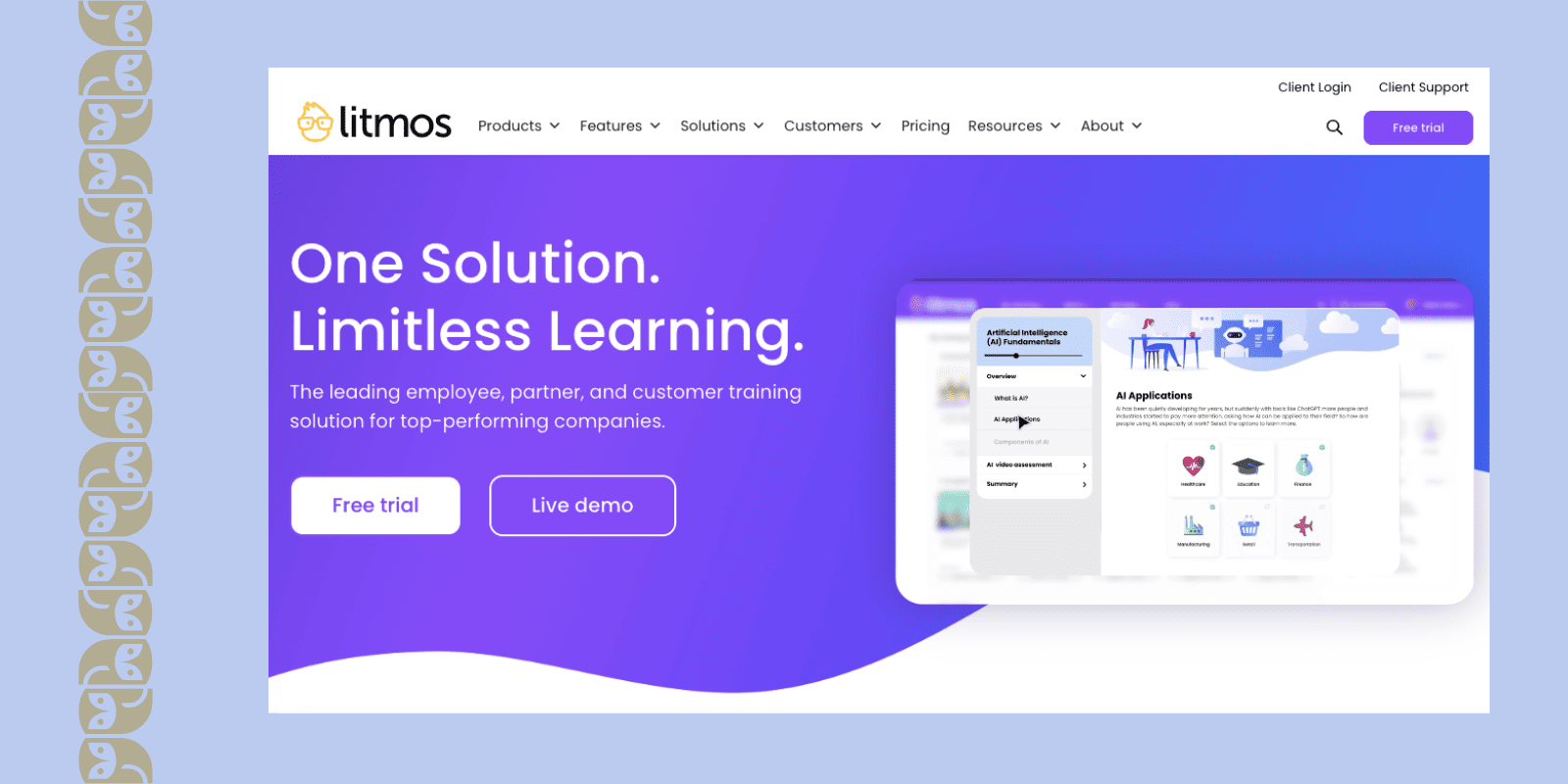
Is there another training management solution that offers similar customization and flexibility? Yeap. Litmos is an intuitive LMS for employee training sessions that brings in customizable learning paths, gamification, and good management.
Importantly, it offers intuitive instructor-led training modules, video assignments, and social learning options. The content creation tool is pretty versatile, backed by the vast library of pre-built programs. That way, it is a scalable solution for internal corporate training and the specific needs of various departments.
Good for: blended learning programs or corporate training within global teams and businesses.
Key features of this Litmos
- Content creation tools. First, there is a library with over 2,000 training courses that can be used to support your training program creation. Also, Litmos provides a responsive editor that supports the creation of dynamic SCORM content.
- Gamification. You can award and encourage learning by awarding achievements and points and offering badges.
- Video assessments. Litmos appears as training and asessement managment software, as students can record and upload videos to complete assignments or communicate their responses.
- Automation. You can easily automate tasks related to enrollment, assignments, and learning path development.
Pros of Litmos:
- Intuitive system that is easy to use and implement.
- Flexible content creation and integration.
- Mobile app and vast content library.
- Customization and smooth integrations.
Cons of Litmos:
- Reporting features can be clunky and hard to use.
- Support can be slow to answer, while some errors may arise.
Pricing: there are three Plans, but pricing is available only upon request.
6. TalentLMS
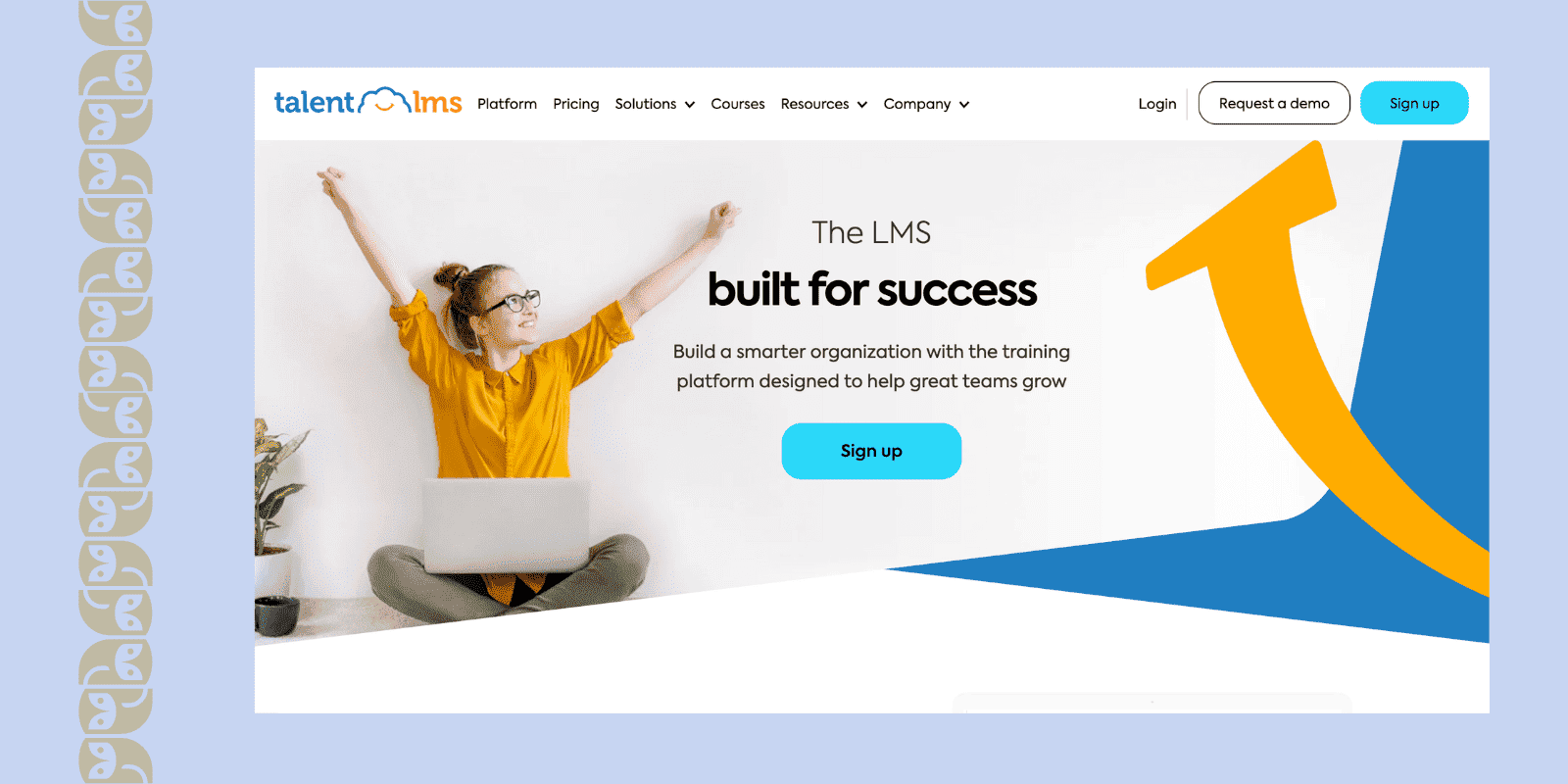
What if you want a content-rich solution for your creative L&D team? TalentLMS is an online training management system that offers versatile content creation tools, great gamification, discussion forums, and proper user administration.
The flexibility of the content editor allows for making diverse training content, while communication and gamification features will support effective engagement with employees. By creating sub-accounts and using branch features, it is easier to deliver training across different departments.
Good for: gamified learning and scalable upskilling programs within mid-sized and large businesses.
Key features of Talents LMS
- User management. TalentLMS offers multiple user roles, provides a branch feature to create different accounts, and allows their customization.
- Flexible course editor. Corporate trainers can embed and integrate diverse multimedia, from importing SCORM and xAPI files to using presentations and videos.
- Gamification. It’s a distinct feature of TalentLMS, meaning you can include Points, Badges, Levels, Leaderboards, and Rewards to encourage training completion. Notably, there are numerous types of badges that can be used.
Pros of TalentLMS
- Ease of use and training management due to user management and branch features.
- Diversity of content options and support of various formats.
- Powerful gamification.
- TalentLMS offers an app for mobile learning and good branding options.
Cons of TalentLMS
- Social learning tools are basic enough.
- API is limited, even though it integrates with some crucial HR software.
- No in-built SCORM editor.
Pricing: The Starter Plan costs $89/mo; the most advanced Premium Plan costs $569/mo; the Enterprise plan is available upon request.
Read more: TalentLMS Pricing Comparison
7. 360Learning
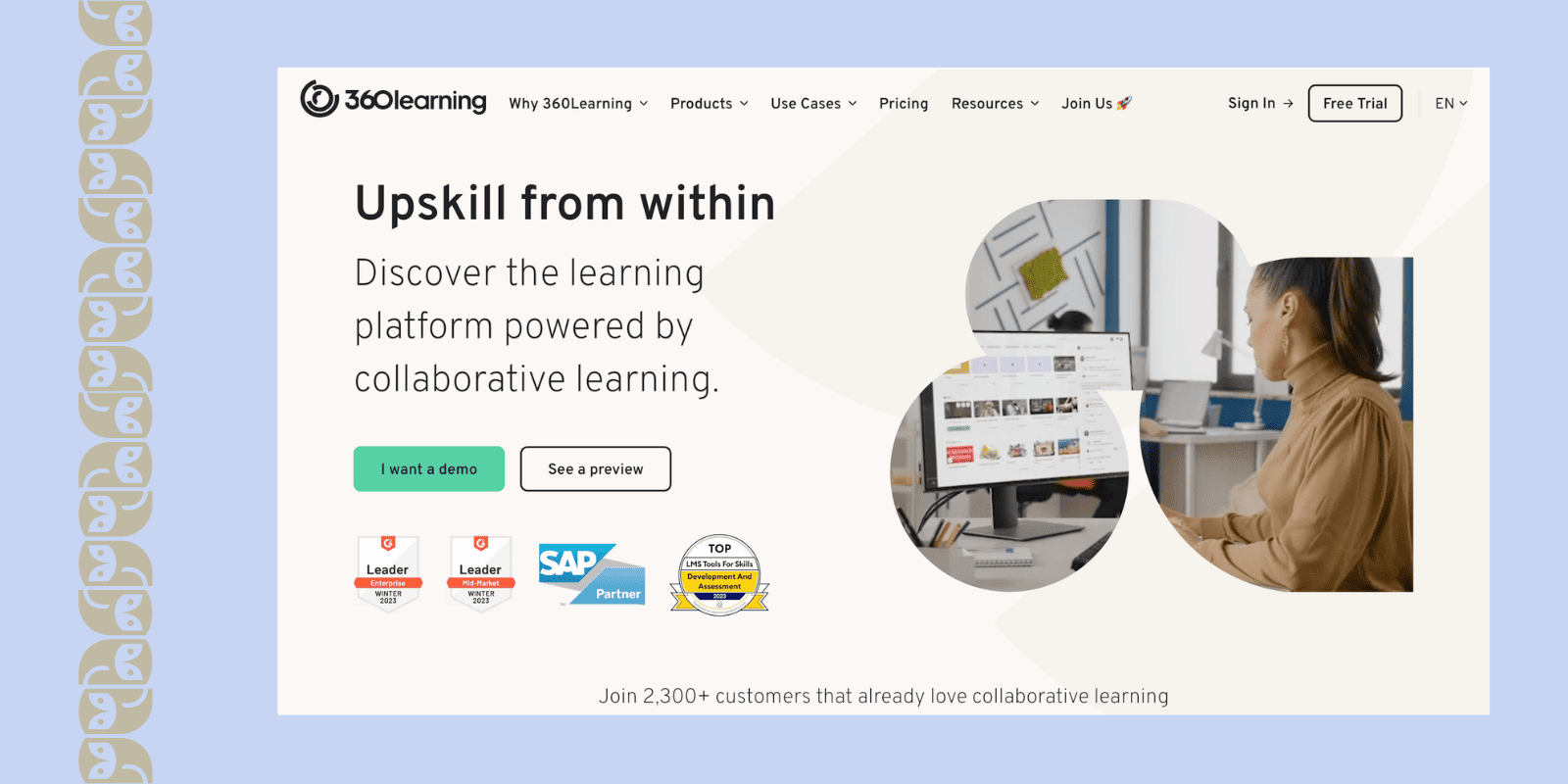
What about collaborative learning platforms similar to what EducateMe offers?
Here is 360Learning, a training management system that positions itself as a powerful collaborative platform, offers LXP features and customization, and brings powerful tools for knowledge sharing.
It provides user-friendly navigation and interactive content creation tools that simplify training development. Considering this, training managers would use it to provide onboarding and coaching sessions or upskill employees from within.
Good for: onboarding, continuous learning, internal corporate training, and knowledge sharing in medium organizations.
Key features of 360 Learning
- Engagement set: 360Learning allows users to use a feed, forum, upvotes, and sharing options for discussion development. At the same time, it offers great gamification features, including badges and leaderboards.
- Content creation. The editor allows different tasks with interactive questions, where you can ask to pick an image or use video as an answer. Also, it offers customizable templates, allows duplicate and co-author courses, and embeds content.
- Learner management. Lastly, 360Learning has decent capabilities for user management, allowing custom user fields, different import options, and good customized reports.
Pros of 360Learning
- The tool is easy to use and implement and is pretty collaborative.
- Encourages employees to engage and improve the work of their peers.
- With a Learning Need Tool, employees can ask for specific learning needs and close this skill gap.
- Offers a mobile app.
Cons of 360Learning
- Lacks course management tools, while reporting is basic.
- Offers no modules and some collaboration is not real-time.
- Hidden costs; can be expensive.
Pricing: The Team Plan is $8/mo per user (up to 100 learners), such solutions as Coaching, Live, and Globalization are not included. For more than 100 learners, you will be asked for a year's commitment.
Read more: Best 360Learning Alternatives
8. Cornerstone
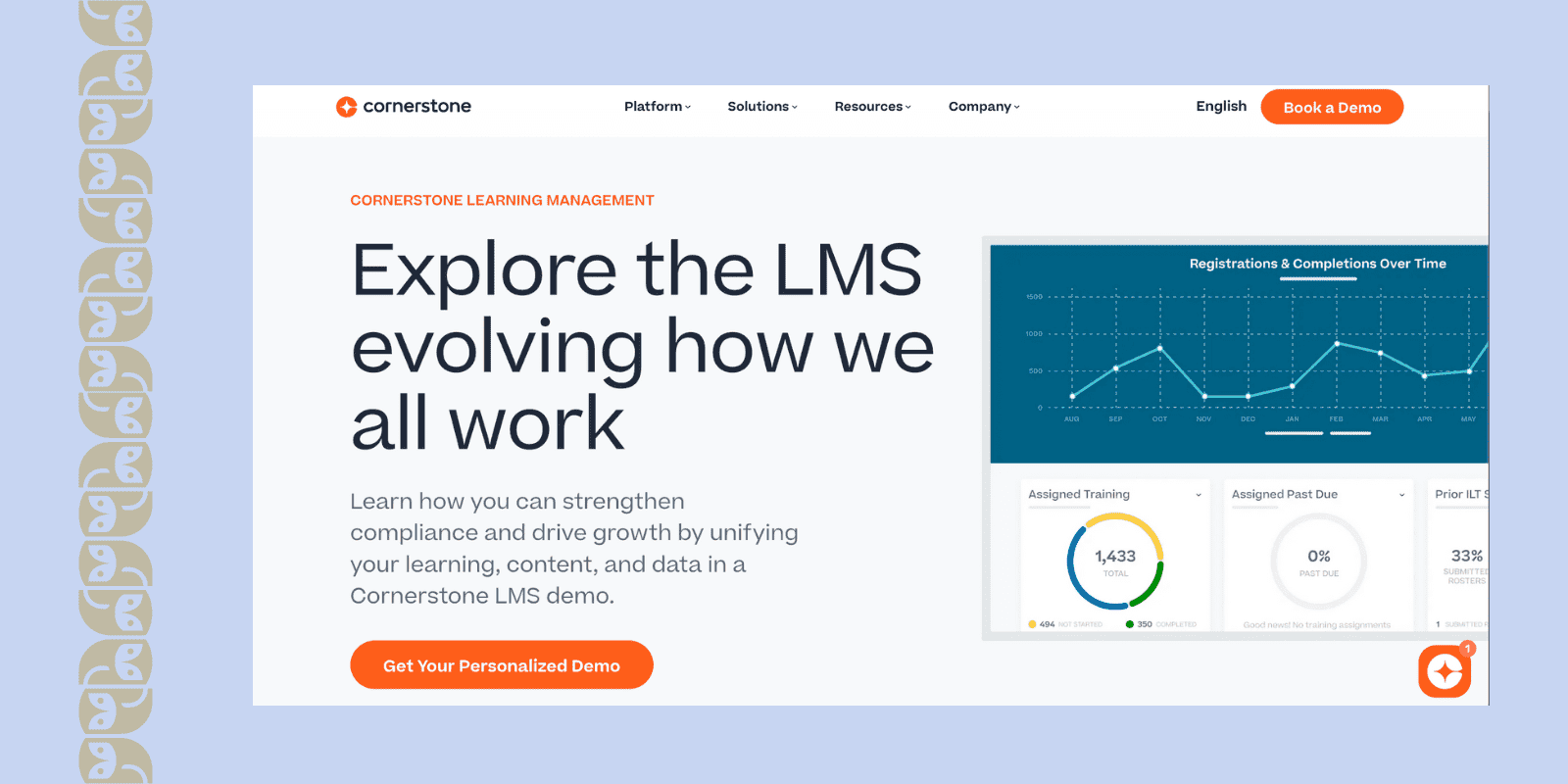
Let’s mention another powerful and universal skill development platform ― Cornerstone. In many ways, it is similar to Docebo.
Cornerstone is a training management system backed by skills intelligence tools, personalized paths, and social learning. This training management platform provides comprehensive tools for workforce and performance management, allowing trainers to identify gaps, roadmap skill development, and suggest training to employees.
Good for: diverse employee development strategies that focus on upskilling, closing gaps, and reskilling within large organizations.
Key features of this Cornerstone
- Skills Intelligence backed by AI. Cornerstone connects competencies to gaps and needs, and based on that helps to assign courses and learning paths. The AI recommendations support the talent marketplace and help identify opportunities.
- Engagement tools. There is room for social learning and discussion thanks to discussion forums and collaborative learning spaces within content collections.
- Content Studio. Thanks to the Studio and Content Subscriptions, a trainer can determine collections and create personalized learning paths for employees.
- Advanced reporting and analytics. There are numerous ways to analyze employee training data, find skills gaps, and track training effectiveness. AI personalized skills recommendations seem to be a great deal for large companies.
Pros of Cornerstone
- Offers powerful gap analysis and comprehensive training management tools.
- Allows road mapping and provides recommendations on skill development.
- Excellent reporting and analytics that allow tracking effectiveness better.
- Powerful integrations with other tools and systems.
Cons of Cornerstone
- Due to comprehensiveness, it can be difficult to implement and use at first.
- Lacks important tools related to content production, relying heavily on content library and curation.
- It can be expensive for small and medium actors.
Pricing: available via contact with the vendor.
9. Looop
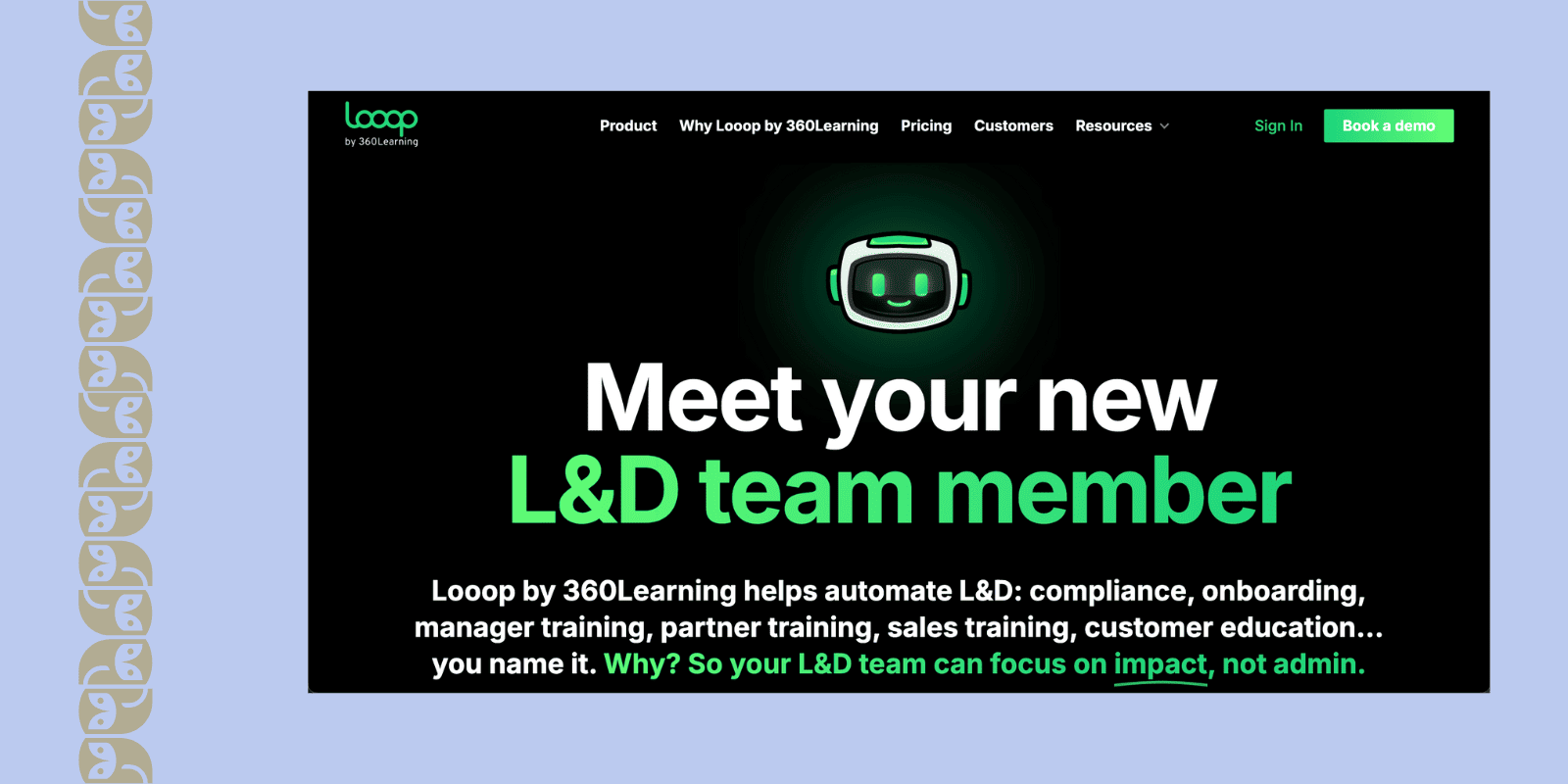
The next online training tool is all about the automation of processes and pathways for training provision.
Looop is a separate product by 360Learning that provides great scalability and automation due to smart triggers and conditions for resource delivery.
That way, trainers and learning specialists can create training paths and share training content or resources with employees. It should be a great addition to the available training tools set and offer centralized training management.
Good for: building a centralized employee training system with different tools and diverse learning needs.
Key features of Looop
- Resource and training builder. To produce content you can use resource builder, import SCORM and xAPI files, and integrate LinkedIn Learning. Also, you can provide certificates and add quizzes.
- Communication tools. Looop offers various types of notifications (email, SMS, app) and can integrate communication apps, like Slack.
- Learning paths and loops. With customizable conditions, you can create specific learning paths and integrate different training tools. It also refers to feedback loops that you can set based on triggers.
Pros of Looop
- Appealing dashboards for data and reports on employee training.
- Mobile app.
- Campaign functionality for the creation of customized learning experiences.
- Flexibility of content used for training.
Cons of Looop
- Course creation and social learning tools are not advanced.
- Steep learning curve.
- Issues with pathways and integrations can occur.
Pricing: upon request.
10. Adobe Learning Manager

Adobe Learning Manager (formerly Adobe Captivate Prime) is an enterprise training management system providing flexible content options, great automation, and excellent opportunities for customization of learning. Besides, it offers a decent management and learning structure.
It means it will suit diverse training types, from instructor-led sessions and self-paced programs to hybrid training and sales training. Also, it offers a “headless LMS,” meaning you can integrate it into your website or other systems.
Good for: training programs within large organizations, extended enterprises, and training companies.
Key features of Adobe Learning Manager
- Distinct customized learning. You can create personalized learner home pages thanks to certain widgets. Also, you can provide recommendations on training content for each employee based on the behavior (via AI tool), organizational needs, or peer activity.
- Management training tools. You can create custom learning plans and paths, using a skill matrix, separate spaces for departments, multiple formats, and a content marketplace.
- Analytics. This online training tool offers comprehensive reports, including role-based, feedback, team performance, and instructor-led training types. Besides, there is a great compliance dashboard and learner transcripts to track performance.
Pros of Adobe Learning Manager
- An immersive learning experience for employees due to interactive elements and gamification.
- Intuitive content creation and helpful marketplace.
- Proper reporting and advanced customization.
Cons of Adobe Learning Manager
- Due to different features, it can be difficult to use.
- Suggestions by AI can be pretty basic.
- Bugs and errors may occur in web and mobile apps.
Pricing: A free trial is available; paid plans are available upon contact with sales.
How to Choose the Best Training Management Software?
- Step#1. Assess training strategy and goals. First, identify specific training objectives, such as onboarding, skill development, or compliance training. From there, you can determine the types of courses to implement.
- Step#2. Set training content and course development priorities. Next, depending on the training program type, evaluate what tools you need. Will you require videos, quizzes, engagement, or gamification tools? Here is a tip: prioritize tools that allow easy development of interactive programs.
- Step#3. Evaluate needs for scalability and mobile functionality. Also, consider the number of employees and the length of the programs. Based on this analysis, you may want to pick scalable software or a mobile learning app to improve knowledge perception.
- Step#4. Think of integration capabilities. Check if the training software integrates seamlessly with your existing systems, such as HR software, communication tools, and content libraries.
- Step#5. Fit in the budget. Many LMSs have hidden costs, thus, take into account prices per user or trainer and additional expenses for essential features and integrations.
Read more: How to Create a Cohort Program in the Workplace
Features of Great Training Management Software
Even if you want to have an LMS for employee training within a specific strategy, you would want to have features for quality training operations. In this regard, you need to consider the following features as a must.
- Course authoring. Quality training starts with robust tools for creating engaging, multimedia-rich employee courses. They may include videos, quizzes, interactive formats, and ready-to-use course templates.
- Collaboration. For proper teamwork and knowledge sharing, your LMS should offer discussion forums, peer reviews, or group projects.
- Management. Advanced user and course management capabilities define how trainers assign roles, track progress, and manage enrollments.
- Automation. Automated processes related to content, management, delivery, and notifications will help save time and reduce administrative workload.
- Reporting. Comprehensive analytics and reporting tools will allow for monitoring of learner progress, tracking course effectiveness, and generating insights for subsequent improvement.
- Branding options: If you want to connect training to company branding and support corporate culture, then white-label LMS is crucial.
- Certificates: Lastly, the ability to issue certificates will help validate employees' achievements upon course completion.
Note. EducateMe is pretty flexible, excelling at collaboration, reporting, and management and without sacrificing other features.
The Benefits of Training Management Systems
Overall, effective employee training management with these features can bring significant benefits to the organization. Which ones? Let’s consider the major ones:
- Enhancing training courses. The employee training management system will link needs to training programs and improve their quality. Also, with the proper analytics, the organization will be able to find insights and better understand employees.
- Improving convenience and knowledge retention. With a set of right features, like management and engagement, the trainers will be able to focus on creating training content and providing value to the employees. Moreover, the engaging courses and relevant skills will add to motivation and knowledge retention.
- Centralized platform or approach. An employee training management software offers an infrastructure for a centralized approach to learning. It means the trainers can build a system that will connect business goals to employee training needs and support corporate culture.
Therefore, training management software is a must for various organizations, from growing businesses to enterprises and large corporations. That way, they will be able to close gaps, retain employees, and get a competitive advantage.
Yet, much depends on how organizations measure training effectiveness. There, robust reporting and learning analytics are crucial to evaluate training effects and calculate ROI.
Note. EducateMe provides powerful analytics and allows for collecting feedback, completion rates, and engagement.
Conclusion
As a result, training management systems are crucial for businesses that want to develop their workforce. However, the choice of the right one significantly depends on goals and training programs. There, you should know that automation, reporting, and management are crucial for training employees. They differentiate training software from a classic learning management system.
But what is the best learning management software?
In terms of collaboration, management, and reporting, EducateMe is a top solution.
For comprehensive skill development, Docebo and Cornerstone are the right training platforms. Litmos, LearnUpon, and Adobe Learning Manager are great for customized learning. Looop is great for the automation of L&D workflows and the creation of a centralized system from different tools.
If you are still in doubt, analyze your needs and get back to the comparison table we have above, or just pick EducateMe as one of the most flexible training management software.























